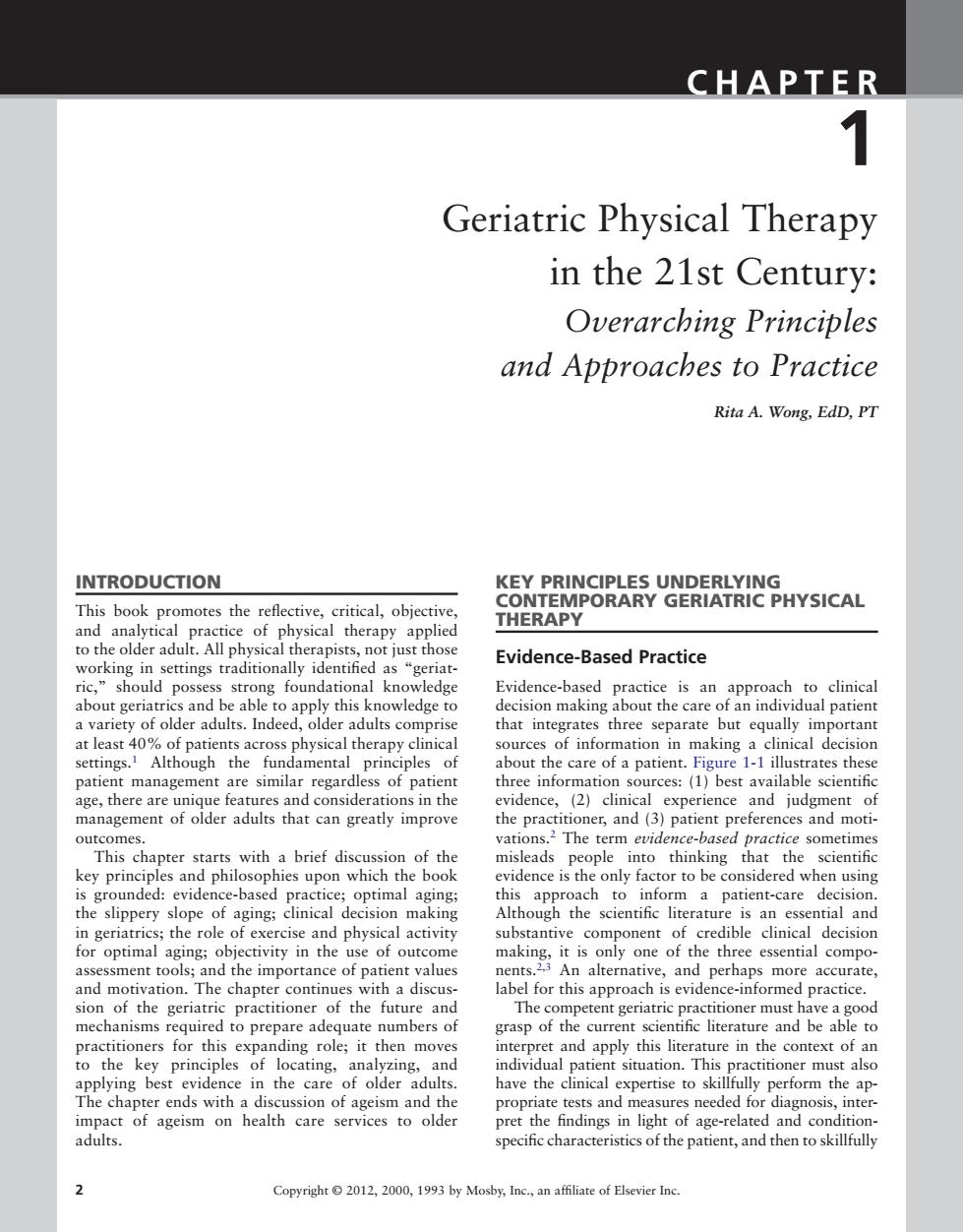正在加载图片...

CHAPTER 1 Geriatric Physical Therapy in the 21st Century: Overarching Principles and Approaches to Practice Rita A.Wong,EdD,PT INTRODUCTION and a of p THERAPY working in settings traditionally identified as "geriat- Evidence-Based Practice ledge ahorectotfoiecrndbfd& dvidence-based practice is an approacd patient at least40%of patients across physical therapy clinical settings.Although the fundamental principles of about the care of a patient.Figure 1-1 illustrates these patient management are similar regardless of patient age,there are ons in the mprove practice ometm This chapter starts with a brief discussion of the misleads people into thinking that the scientific evidence is the only factor to be considered when using hegrpnded practice:optima this approach a patient-care de geriabctivity in the use of ouy the role o rcise and physical makingoy one of the three ctal com nt of edible clinical decision ofac chapter con a h is evic rmed practice. mechanisms required o enare aded nding role:it then moves pret and apply this literature in the context of an in the ave expertise to yperform the ap. pret the findings in light of age-related and condition- adults. specific characteristics of the patient,and then to skillfully Copyright2012,2000,1993 by Mosby,Inc.an affiliate of Elsevier Inc2 Copyright © 2012, 2000, 1993 by Mosby, Inc., an affiliate of Elsevier Inc. C H A P T E R 1 Geriatric Physical Therapy in the 21st Century: Overarching Principles and Approaches to Practice Rita A. Wong, EdD, PT INTRODUCTION This book promotes the reflective, critical, objective, and analytical practice of physical therapy applied to the older adult. All physical therapists, not just those working in settings traditionally identified as “geriatric,” should possess strong foundational knowledge about geriatrics and be able to apply this knowledge to a variety of older adults. Indeed, older adults comprise at least 40% of patients across physical therapy clinical settings.1 Although the fundamental principles of patient management are similar regardless of patient age, there are unique features and considerations in the management of older adults that can greatly improve outcomes. This chapter starts with a brief discussion of the key principles and philosophies upon which the book is grounded: evidence-based practice; optimal aging; the slippery slope of aging; clinical decision making in geriatrics; the role of exercise and physical activity for optimal aging; objectivity in the use of outcome assessment tools; and the importance of patient values and motivation. The chapter continues with a discussion of the geriatric practitioner of the future and mechanisms required to prepare adequate numbers of practitioners for this expanding role; it then moves to the key principles of locating, analyzing, and applying best evidence in the care of older adults. The chapter ends with a discussion of ageism and the impact of ageism on health care services to older adults. KEY PRINCIPLES UNDERLYING CONTEMPORARY GERIATRIC PHYSICAL THERAPY Evidence-Based Practice Evidence-based practice is an approach to clinical decision making about the care of an individual patient that integrates three separate but equally important sources of information in making a clinical decision about the care of a patient. Figure 1-1 illustrates these three information sources: (1) best available scientific evidence, (2) clinical experience and judgment of the practitioner, and (3) patient preferences and motivations.2 The term evidence-based practice sometimes misleads people into thinking that the scientific evidence is the only factor to be considered when using this approach to inform a patient-care decision. Although the scientific literature is an essential and substantive component of credible clinical decision making, it is only one of the three essential components.2,3 An alternative, and perhaps more accurate, label for this approach is evidence-informed practice. The competent geriatric practitioner must have a good grasp of the current scientific literature and be able to interpret and apply this literature in the context of an individual patient situation. This practitioner must also have the clinical expertise to skillfully perform the appropriate tests and measures needed for diagnosis, interpret the findings in light of age-related and conditionspecific characteristics of the patient, and then to skillfully